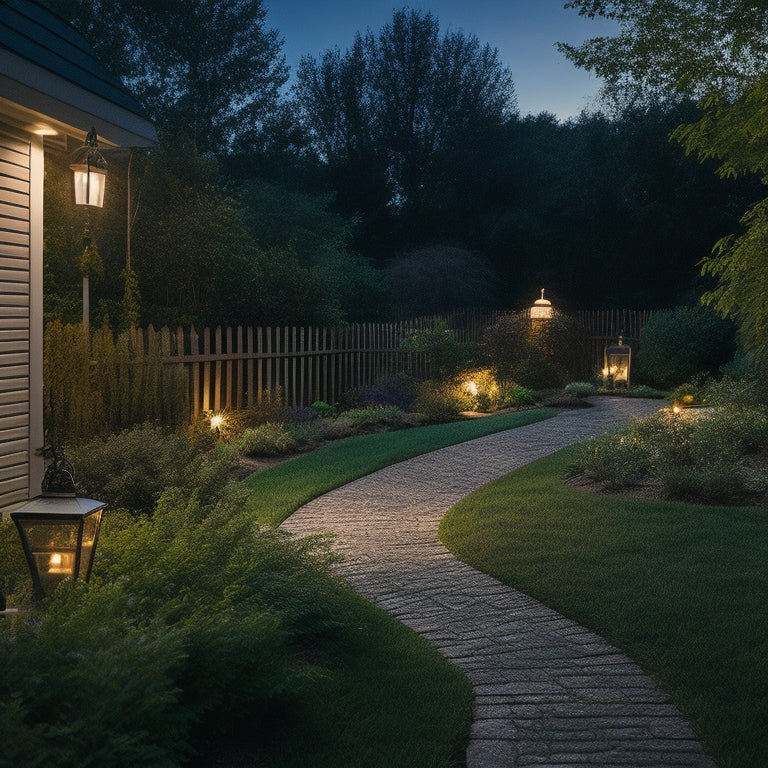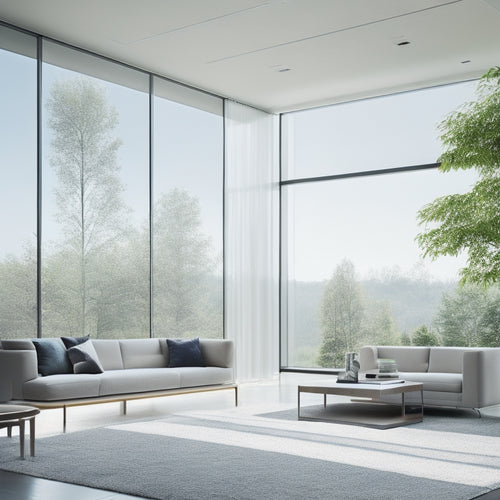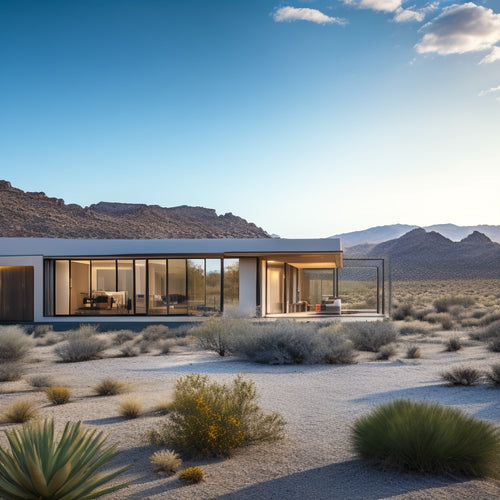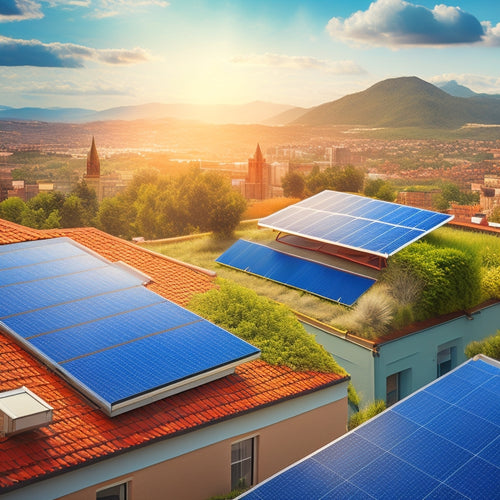
10 Best Solar Outdoor Lighting Setup Tricks for Homeowners
Share
As you plan your solar outdoor lighting setup, you'll want to assess your outdoor space's unique needs, choosing the right fixtures and solar panels for the job. Identify areas requiring lighting, consider lighting design factors, and prioritize dark spots for strategic placement. Select high-efficiency solar panels designed for outdoor use, and optimize their positioning for maximum energy absorption. Choose fixtures that complement your outdoor area's style and function, and prioritize energy efficiency and durability. By following these tricks, you'll be well on your way to creating a safe, functional, and visually appealing outdoor oasis - and with a closer look, you'll uncover even more opportunities to take your solar lighting setup to the next level.
Key Takeaways
- Assess your outdoor space to identify areas requiring lighting for ambiance, task lighting, or safety, and prioritize dark spots for solar lighting.
- Choose high-efficiency solar panels designed for outdoor use, and position them for optimal energy harvesting, considering angle, orientation, and shading.
- Select suitable lighting fixtures that complement your outdoor area's style and function, and optimize solar panel array for energy production.
- Implement motion sensor activation to increase energy efficiency and enhance security, and customize sensitivity and detection range for specific needs.
- Regularly maintain your solar outdoor lighting setup by cleaning fixtures, inspecting wiring and batteries, and adjusting solar panel angle for optimal performance.
Assess Your Outdoor Lighting Needs
As you step out into your yard, take a moment to observe the layout of your outdoor space.
Take note of the areas where you spend most of your time, such as patios, walkways, and gardens. This outdoor space assessment will help you identify the zones that require lighting.
Reflect on the purpose of each zone: is it for ambiance, task lighting, or safety? Make a mental map of the areas that need illumination.
Next, think about the lighting design considerations: the type of fixtures, their placement, and the desired level of brightness.
You may also want to think about incorporating eco-friendly charging solutions green energy infrastructure to power your outdoor lighting, reducing your carbon footprint.
Will you need pathway lights, spotlights, or floodlights?
Choose the Right Solar Panels
With your outdoor lighting needs evaluated, it's time to select the right solar panels to power your outdoor lighting setup.
You'll need to contemplate the type of solar panel that suits your setup best. Monocrystalline silicon panels offer high efficiency, while polycrystalline panels provide a cost-effective alternative. Thin-film panels, on the other hand, are ideal for small-scale installations.
High-efficiency solar panels with conversion rates up to 23% advanced charging algorithms can considerably increase energy yield, reducing surface area requirements.
When choosing your solar panels, verify they're designed for outdoor use and can withstand harsh weather conditions.
Follow installation guidelines carefully, considering the panel's tilt, orientation, and distance from obstacles to maximize energy absorption.
Select Suitable Lighting Fixtures
You'll need to take into account three critical factors when selecting suitable lighting fixtures for your outdoor setup: the type of fixture, its lumen output, and its durability.
Different fixture types, such as pathway lights or spotlights, serve distinct purposes and affect the overall aesthetic.
To guarantee peak energy production, it's crucial to optimize your solar panel array by assessing the tilt, sizing, and orientation of your solar panels.
Fixture Type Matters
Outdoor spaces boast unique characteristics, and your lighting fixtures should adapt to these conditions.
You'll want to choose fixtures that complement your outdoor area's style and function. Consider the fixture styles that resonate with your home's aesthetic appeal. For example, modern fixtures with clean lines and minimalist designs can enhance contemporary spaces, while traditional fixtures with ornate details can complement classic homes.
Pathway lights, spotlights, and floodlights each serve distinct purposes, so select fixtures that address specific needs, such as illuminating walkways or accentuating landscaping features.
As you choose your fixtures, keep in mind the importance of energy efficiency and solar-powered solutions to reduce your carbon footprint and energy costs.
Lumen Output Counts
Lumen output counts are a crucial consideration when selecting suitable lighting fixtures for your outdoor space. You want to guarantee you're getting the right amount of brightness for your specific needs.
When choosing solar lights, look for fixtures with high lumen efficiency to maximize energy harvesting. With the rising popularity of electric cars, understanding kilowatts vs. kilowatt-hours can also help homeowners optimize their energy consumption.
For pathways and walkways, 100-200 lumens per fixture should provide sufficient brightness. For security lighting, aim for 400-600 lumens to deter intruders. Accent lighting typically requires lower brightness levels, around 50-100 lumens.
Consider the area you're illuminating and the desired brightness levels to choose the perfect fixtures for your outdoor space. By selecting fixtures with the right lumen output, you'll achieve the perfect balance of ambiance and visibility.
Durability Is Key
Weather-resistant fixtures, built to withstand the elements, form the backbone of a reliable outdoor lighting setup.
When selecting suitable lighting fixtures, you'll want to prioritize material quality and weather resistance. Look for fixtures with durable materials like stainless steel, aluminum, or polycarbonate that can withstand harsh outdoor conditions.
Additionally, consider fixtures with IP65 or higher ratings, which guarantee protection against dust and water.
Regular maintenance is also essential for longevity. Clean your fixtures regularly to prevent dirt buildup, and inspect them for signs of wear or damage.
Plan for Adequate Coverage
As you map out your outdoor lighting setup, you'll want to identify dark spots around your property where shadows can hide potential safety hazards or obscure key features.
To optimize light placement, start by standing in different areas of your yard at night, taking note of where the darkness falls and how it affects your visibility.
Identify Dark Spots
Walking through your property at night, you'll likely notice areas where darkness prevails, making it difficult to find your way or appreciate your outdoor space.
To guarantee adequate coverage, identify these dark spots and prioritize them for solar lighting. This involves more than just placing lights randomly; it requires strategic solar light positioning for ideal nighttime visibility.
-
Pay attention to areas where shadows fall, such as beneath trees or bushes, or alongside buildings.
-
Note the pathways and walkways that need illumination to guarantee safe passage.
-
Identify any dark corners or recesses that could benefit from additional lighting to enhance security and ambiance.
Optimize Light Placement
Beyond identifying dark spots, optimizing light placement is crucial to achieve adequate coverage.
You'll want to strategically position your solar lights to maximize their effectiveness. Consider the light direction and illumination angle to guarantee the area is well-lit.
For pathways, place lights 6-8 feet apart, and angle them 10-15 degrees to create a soft, gentle glow.
For security lighting, position lights 8-10 feet off the ground, with a narrower illumination angle (30-40 degrees) to cast a concentrated beam.
For accent lighting, use a wider illumination angle (60-90 degrees) to highlight specific features.
Optimize Battery Life and Storage
About five times a year, you'll find yourself swapping out batteries in your outdoor lighting setup, which can be a frustratingly frequent task.
To break free from this cycle, it's crucial to enhance your battery life and storage.
To maximize your battery capacity, focus on energy efficiency. Here are a few strategies to get you started:
- Choose high-capacity batteries with a low self-discharge rate to minimize energy loss.
- Make sure your solar panels are positioned for ideal energy harvesting, considering factors like angle, orientation, and shading.
- Consider using lithium-ion batteries, which offer higher energy density and longer lifetimes compared to traditional lead-acid batteries.
Consider Motion Sensor Activation
By optimizing battery life and storage, you've taken a significant step towards a hassle-free outdoor lighting setup.
Now, consider motion sensor activation to enhance your solar outdoor lighting game. This feature allows lights to turn on only when needed, increasing energy efficiency and extending battery life.
Motion sensors also provide enhanced security benefits by deterring intruders and illuminating potential threats. With motion sensor activation, you can customize the sensitivity and range of detection to suit your specific needs.
This means you can set lights to turn on when you approach, but not when pets or wildlife pass by. By combining energy efficiency with targeted illumination, you'll enjoy a more secure and convenient outdoor space.
Install Away From Shade Sources
Most of your solar outdoor lights will be installed in areas that receive direct sunlight for a significant part of the day, as this is vital for recharging their batteries.
However, it's important to install them away from shade sources to guarantee peak performance. Conduct a shade analysis to identify areas with minimal shade, especially during peak sun hours.
-
Orient your solar panels to face the direction with the least amount of shade, guaranteeing maximum energy harvesting.
-
Avoid installing lights near trees, buildings, or other structures that can cast shadows on your solar panels.
-
Consider the seasonal changes in sunlight patterns to adjust your solar panel orientation accordingly.
Mind the Cable Management
Tuck cables away neatly to maintain a clutter-free outdoor space and guarantee your lighting setup looks polished.
You'll want to prioritize cable organization to keep your solar outdoor lighting system looking sleek and modern. Start by routing cables along walls, under eaves, or behind bushes to achieve wire concealment.
Use cable ties, clips, or zip ties to secure them in place, ensuring they're not visible from any angle.
Consider investing in cable management systems specifically designed for outdoor use, which can withstand the elements.
Schedule Regular Maintenance
Performing regular maintenance on your outdoor lighting system is essential to guarantee it continues to function at its best and safely.
You'll want to set aside time each season to perform a series of checks to verify your lights are shining bright.
Here are a few key tasks to add to your maintenance schedule:
-
Clean your fixtures regularly using gentle cleaning techniques to prevent dirt buildup and maintain peak light output.
-
Perform seasonal checkups to inspect wiring, batteries, and bulbs, replacing them as needed to prevent system failures.
-
Inspect light positioning and weatherproofing to verify your system is securely fastened and protected from the elements.
Monitor Performance and Adjust
As you've guaranteed your outdoor lighting system is well-maintained, it is crucial to monitor its performance to identify areas that need adjustment. You should track key performance metrics, such as:
| Metric | Target Range | Adjustment |
|---|---|---|
| Lumen Output | 80-100% | Adjust solar panel angle or clean panels |
| Battery Life | 8-12 hours | Check wiring connections or replace batteries |
| Charging Time | 4-6 hours | Clean solar panels or adjust charging settings |
Frequently Asked Questions
Can I Mix and Match Different Solar Panel Brands and Models?
"Don't count your chickens before they hatch" - mixing and matching solar panel brands and models can be a recipe for disaster. You'll need to verify solar panel compatibility, considering factors like voltage and current output, to avoid compromising brand performance and overall system efficiency.
Will Solar Outdoor Lights Attract Pests or Wildlife?
You'll be relieved to know that solar outdoor lights typically don't attract pests or wildlife, as they don't emit heat or UV light that'd draw them in; instead, you'll enjoy the solar light benefits of energy independence and a pest-free ambiance.
Can I Use Solar Lights in Areas With High Winds or Storms?
Will your solar lights stand tall against the fury of the wind? You can, in fact, use solar lights in areas with high winds or storms, thanks to wind resistance and storm durability features that'll keep them shining bright.
Do Solar Lights Require Any Special Permits or Licenses?
You'll need to check local installation guidelines and zoning regulations before setting up your solar lights, ensuring you comply with permits and licenses required by your area, giving you the freedom to illuminate your outdoor space without hassle.
Can I Use Solar Lights to Charge Other Devices Like Phones?
You're wondering if you can utilize solar power to charge devices like phones. While it's technically possible, most solar lights aren't designed for high-capacity solar charging, and device compatibility is limited, making it less practical for everyday use.
Related Posts
-

3 Sun-Powered Automated Shades for Energy-Savvy Homes
You're looking to change your home into an energy-savvy haven, and sun-powered automated shades are an essential step...
-

7 Best Geothermal Cooling Systems for Hot Climate Homes
You're evaluating geothermal cooling systems for your hot climate home, and you want to know the top options. Look fo...
-

What Roofing Materials Best Protect Our Planet?
As you consider the environmental impact of your building, you're likely to find that the roofing material you choose...


